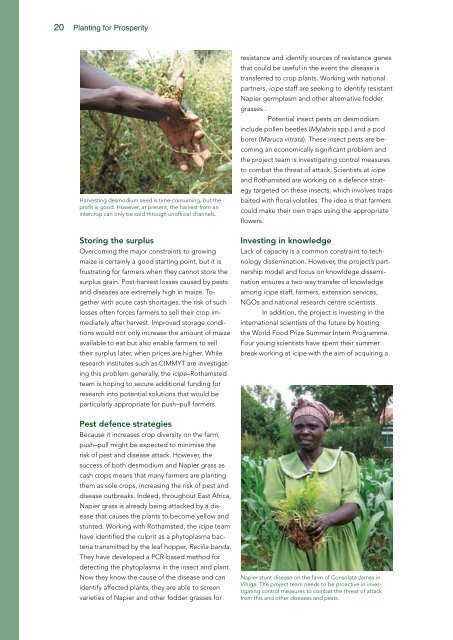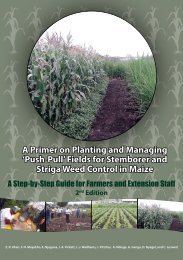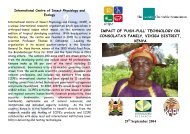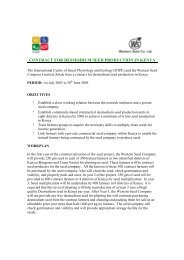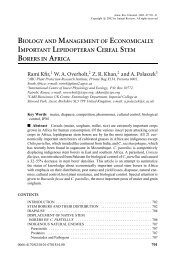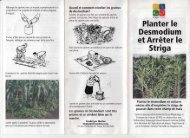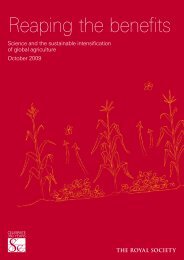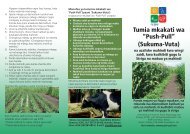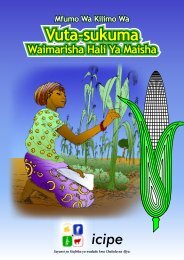a model for Africa's green revolution - Push-Pull
a model for Africa's green revolution - Push-Pull
a model for Africa's green revolution - Push-Pull
Create successful ePaper yourself
Turn your PDF publications into a flip-book with our unique Google optimized e-Paper software.
20 Planting <strong>for</strong> Prosperity<br />
Harvesting desmodium seed is time-consuming, but the<br />
profit is good. However, at present, the harvest from an<br />
intercrop can only be sold through unofficial channels.<br />
resistance and identify sources of resistance genes<br />
that could be useful in the event the disease is<br />
transferred to crop plants. Working with national<br />
partners, icipe staff are seeking to identify resistant<br />
Napier germplasm and other alternative fodder<br />
grasses .<br />
Potential insect pests on desmodium<br />
include pollen beetles (Mylabris spp.) and a pod<br />
borer (Maruca vitrata). These insect pests are becoming<br />
an economically significant problem and<br />
the project team is investigating control measures<br />
to combat the threat of attack. Scientists at icipe<br />
and Rothamsted are working on a defence strategy<br />
targeted on these insects, which involves traps<br />
baited with floral volatiles. The idea is that farmers<br />
could make their own traps using the appropriate<br />
flowers.<br />
Storing the surplus<br />
Overcoming the major constraints to growing<br />
maize is certainly a good starting point, but it is<br />
frustrating <strong>for</strong> farmers when they cannot store the<br />
surplus grain. Post-harvest losses caused by pests<br />
and diseases are extremely high in maize. Together<br />
with acute cash shortages, the risk of such<br />
losses often <strong>for</strong>ces farmers to sell their crop immediately<br />
after harvest. Improved storage conditions<br />
would not only increase the amount of maize<br />
available to eat but also enable farmers to sell<br />
their surplus later, when prices are higher. While<br />
research institutes such as CIMMYT are investigating<br />
this problem generally, the icipe–Rothamsted<br />
team is hoping to secure additional funding <strong>for</strong><br />
research into potential solutions that would be<br />
particularly appropriate <strong>for</strong> push–pull farmers.<br />
Pest defence strategies<br />
Because it increases crop diversity on the farm,<br />
push–pull might be expected to minimise the<br />
risk of pest and disease attack. However, the<br />
success of both desmodium and Napier grass as<br />
cash crops means that many farmers are planting<br />
them as sole crops, increasing the risk of pest and<br />
disease outbreaks. Indeed, throughout East Africa,<br />
Napier grass is already being attacked by a disease<br />
that causes the plants to become yellow and<br />
stunted. Working with Rothamsted, the icipe team<br />
have identified the culprit as a phytoplasma bacteria<br />
transmitted by the leaf hopper, Recilia banda.<br />
They have developed a PCR-based method <strong>for</strong><br />
detecting the phytoplasma in the insect and plant.<br />
Now they know the cause of the disease and can<br />
identify affected plants, they are able to screen<br />
varieties of Napier and other fodder grasses <strong>for</strong><br />
Investing in knowledge<br />
Lack of capacity is a common constraint to technology<br />
dissemination. However, the project’s partnership<br />
<strong>model</strong> and focus on knowldege dissemination<br />
ensures a two-way transfer of knowledge<br />
among icipe staff, farmers, extension services,<br />
NGOs and national research centre scientists.<br />
In addition, the project is investing in the<br />
international scientists of the future by hosting<br />
the World Food Prize Summer Intern Programme.<br />
Four young scientists have spent their summer<br />
break working at icipe with the aim of acquiring a<br />
Napier stunt disease on the farm of Consolata James in<br />
Vihiga. The project team needs to be proactive in investigating<br />
control measures to combat the threat of attack<br />
from this and other diseases and pests.


